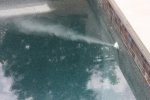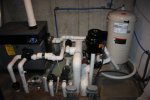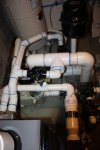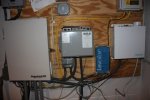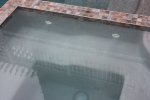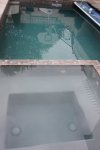Shieldsfx said:
Richard, I believe you are right about the spa flow/number of jets being a factor in this saga. Again they are 20-25 feet from SWG but there are 8 jets in the SPA. Remember, the pool Jets are about 10-15 feet from SWG and only two jets.
Fran,
So the problem occurs the worst with the SWG on, worse with the heater also on, and through the pool's 2 jets at 30 GPM so 15 GPM per jet. The problem is far less at faster speed, 60 GPM so 30 GPM per jet. The problem does not show up at the spa at 60 GPM with 8 jets which would be 7.5 GPM per jet (you never said if you tried running the spa at low-speed, which isn't something you'd normally do).
So if the split in plumbing for the jets were closer to the SWG, and if the individual pipes to the jets were 1.5" (they may be 2" at the pump, but are likely smaller when split to each jet), then the following shows the velocity in the pipe, distances, and calculated time in the pipe:
POOL @ 60 GPM: 30 GPM per jet, 4.73 feet/second, 10-15 feet, 2.1 to 3.2 seconds -- result: very faint to no milky substance
POOL @ 30 GPM: 15 GPM per jet, 2.36 feet/second, 10-15 feet, 4.2 to 6.4 seconds -- result: faint to darker (with heater) milky substance
SPA @ 60 GPM: 7.5 GPM per jet, 1.18 feet/second, 20-25 feet, 16.9 to 21.1 seconds -- result: no milky substance
SPA @ 30 GPM: 3.75 GPM per jet, 0.59 feet/second, 20-25 feet, 33.8 to 41.3 seconds -- result: not tested
So it looks like the slower flow rate through the SWG may cause larger more visible bubbles to form. These don't spend very long in the pipe when going to the pool so show up more, while in the spa there is enough time for these bubbles to dissolve or otherwise disperse to not look milky. Also, larger bubbles have a lower surface area to volume ratio so dissolve their contents more slowly than smaller bubbles.
We still don't know if the bubbles are hydrogen gas or chlorine, but I suspect they are chlorine since longer time in the pipe has them disappear (by dissolving into the water). The hydrogen gas bubbles probably don't dissolve much since the water should get saturated with hydrogen gas fairly quickly. Chlorine gas is pale green, but your milky stream looks off-white without a tint, but chlorine gas in many bubbles in water might not look green.
One way to tell if there is undissolved chlorine gas coming out of the jets is to dynamically measure the pH of that jet stream in the case with slow flow in the pool with lots of bubbles compared to the spa. You can't just do a standard sample collection for this since the chlorine gas would have time to dissolve before you could measure the pH -- it needs to be something more dynamic such as a pH probe or perhaps a pH test strip viewed in the water. The pH of the water should be higher if there is undissolved chlorine gas.
Richard


